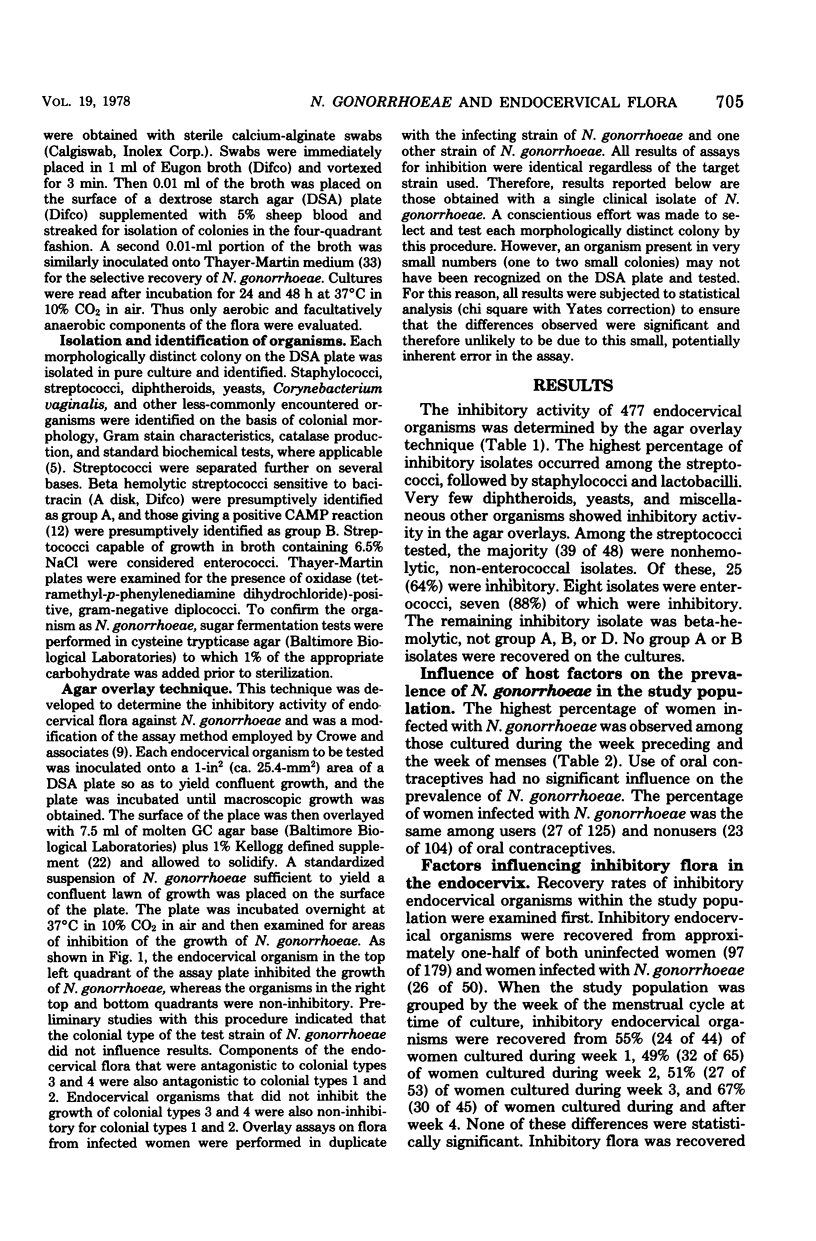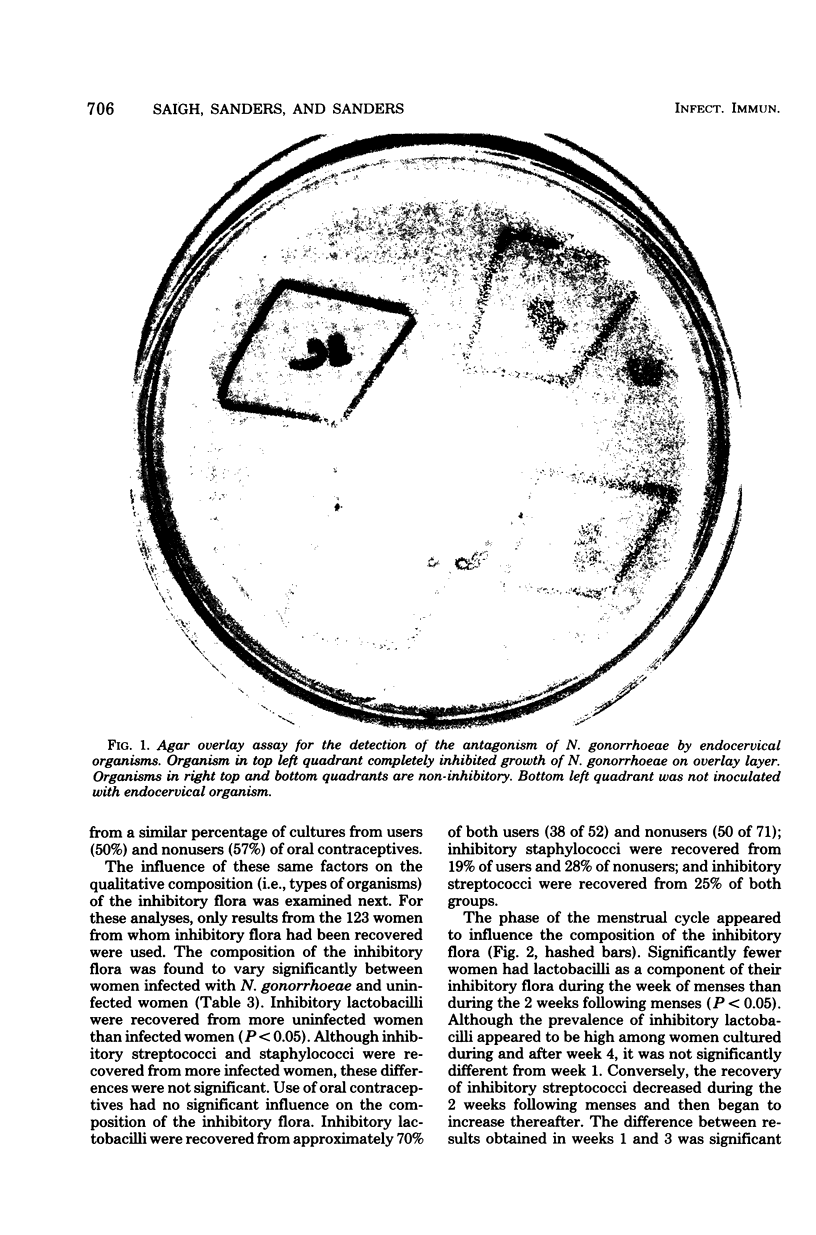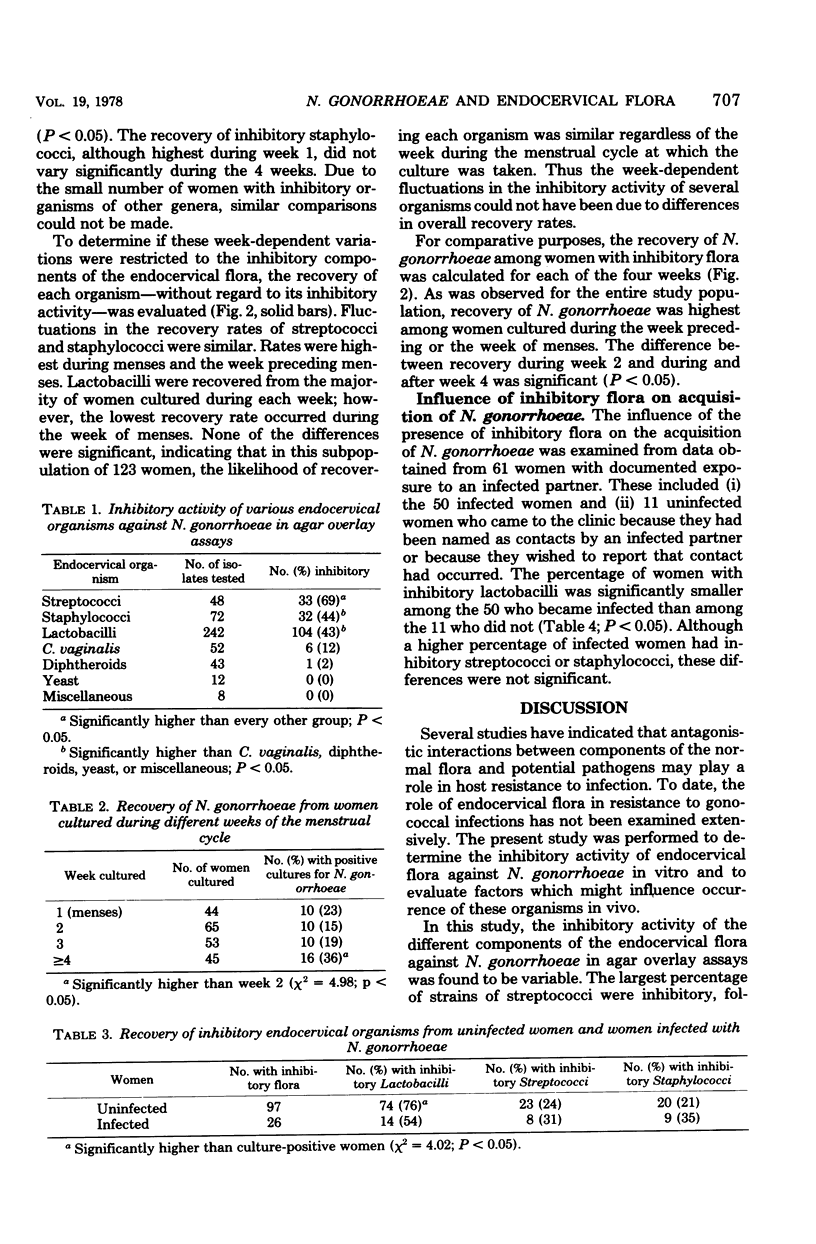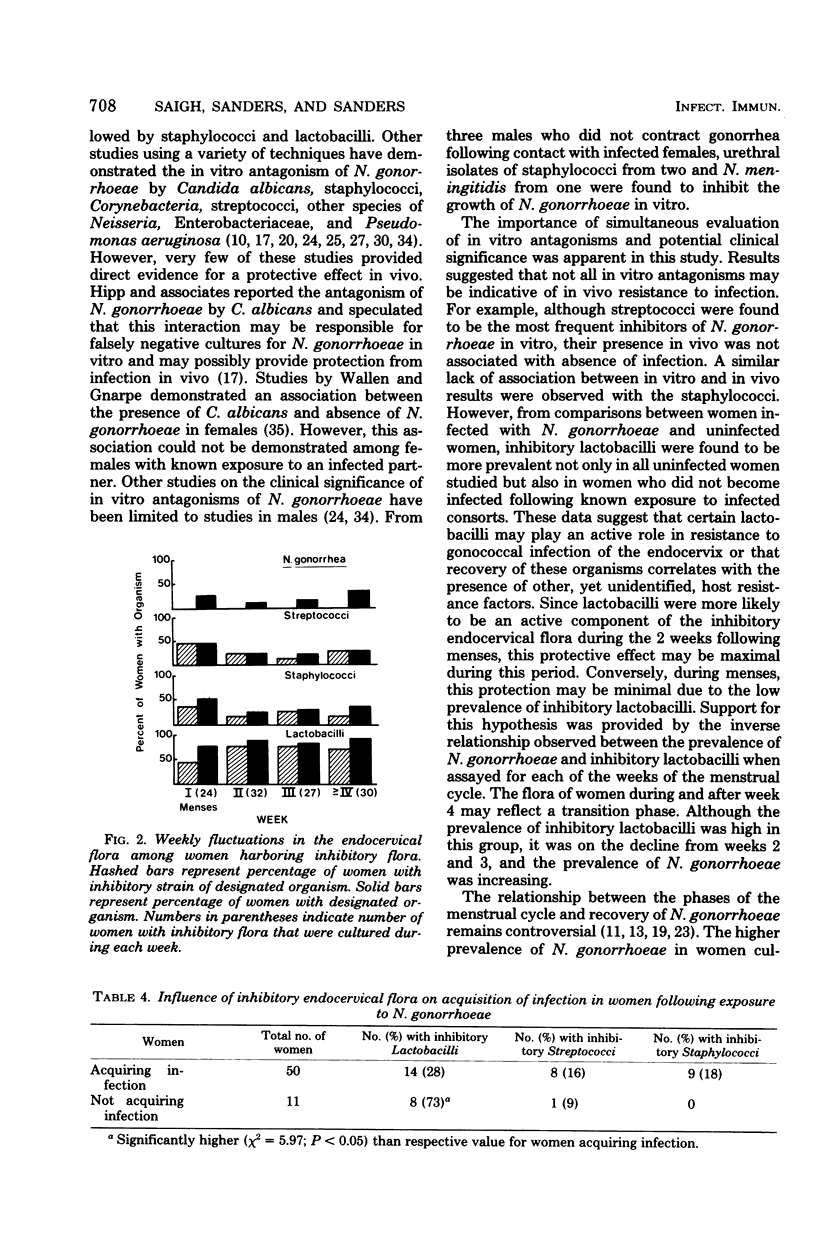Abstract
The ability of aerobic and facultatively anaerobic endocervical flora to inhibit the growth of Neisseria gonorrhoeae in vitro was assayed. Factors influencing the occurrence of inhibitory components of the flora in vivo were evaluated. Endocervical swabs were obtained from 229 women at a local venereal disease clinic. Endocervical flora and N. gonorrhoeae were isolated and identified, and the ability of the flora to inhibit the growth of N. gonorrhoeae was determined by an agar overlay assay. Results revealed the most active inhibitors to be streptococci, staphylococci, and lactobacilli, in that order. Among only those women harboring inhibitory endocervical flora, inhibitory lactobacilli were recovered from fewer women infected with N. gonorrhoeae than uninfected women (P less than 0.05). Among women having contact with an infected partner, those who subsequently developed gonorrhea were less likely to have inhibitory lactobacilli than those who did not become infected (P less than 0.05). No other significant differences in the composition of the inhibitory flora were noted between infected and uninfected women. During the 2 weeks following menses, recovery of inhibitory lactobacilli on culture was highest, whereas recovery of N. gonorrhoeae was lowest. These observations suggest that the presence of certain lactobacilli may reduce risk of acquisition of N. gonorrhoeae following exposure to infected partners and that the potential protective effect may be greatest during the 2 weeks after menses.
Full text
PDF






Images in this article
Selected References
These references are in PubMed. This may not be the complete list of references from this article.
- Berger G. S., Keith L., Moss W. Prevalence of gonorrhoea among women using various methods of contraception. Br J Vener Dis. 1975 Oct;51(5):307–309. doi: 10.1136/sti.51.5.307. [DOI] [PMC free article] [PubMed] [Google Scholar]
- Bhattacharyya M. N., Jephcott A. E. Diagnosis of gonorrhea in women--Influence of the contraceptive pill. J Am Vener Dis Assoc. 1976 Mar;2(3):21–24. [PubMed] [Google Scholar]
- Bisno A. L., Ofek I., Beachey E. H., Chandler R. W., Curran J. W. Human immunity to Neisseria gonorrhoeae: acquired serum opsonic antibodies. J Lab Clin Med. 1975 Aug;86(2):221–229. [PubMed] [Google Scholar]
- Buchanan T. M., Swanson J., Holmes K. K., Kraus S. J., Gotschlich E. C. Quantitative determination of antibody to gonococcal pili. Changes in antibody levels with gonococcal infection. J Clin Invest. 1973 Nov;52(11):2896–2909. doi: 10.1172/JCI107486. [DOI] [PMC free article] [PubMed] [Google Scholar]
- Chipperfield E. J., Evans B. A. Effect of local infection and oral contraception on immunoglobulin levels in cervical mucus. Infect Immun. 1975 Feb;11(2):215–221. doi: 10.1128/iai.11.2.215-221.1975. [DOI] [PMC free article] [PubMed] [Google Scholar]
- Cohen L., Thomas G. Copper versus the gonococcus in vivo. Br J Vener Dis. 1974 Oct;50(5):364–366. doi: 10.1136/sti.50.5.364. [DOI] [PMC free article] [PubMed] [Google Scholar]
- Crowe C. C., Sanders W. E., Jr, Longley S. Bacterial interference. II. Role of the normal throat flora in prevention of colonization by group A Streptococcus. J Infect Dis. 1973 Oct;128(4):527–532. doi: 10.1093/infdis/128.4.527. [DOI] [PubMed] [Google Scholar]
- Dajani A. S., Tom M. C., Law D. J. Viridins, bacteriocins of alpha-hemolytic streptococci: isolation, characterization, and partial purification. Antimicrob Agents Chemother. 1976 Jan;9(1):81–88. doi: 10.1128/aac.9.1.81. [DOI] [PMC free article] [PubMed] [Google Scholar]
- Dans P. E., Judson F. The establishment of a venereal disease clinic: II. An appraisal of current diagnostic methods in uncomplicated urogenital and rectal gonorrhea. J Am Vener Dis Assoc. 1975 Mar;1(3):107–112. [PubMed] [Google Scholar]
- Darling C. L. Standardization and evaluation of the CAMP reaction for the prompt, presumptive identification of Streptococcus agalactiae (Lancefield group B) in clinical material. J Clin Microbiol. 1975 Feb;1(2):171–174. doi: 10.1128/jcm.1.2.171-174.1975. [DOI] [PMC free article] [PubMed] [Google Scholar]
- Falk V., Krook G. Do results of culture for gonococci vary with sampling phase of menstrual cycle? Acta Derm Venereol. 1967;47(3):190–193. [PubMed] [Google Scholar]
- Fiscina B., Oster G. K., Oster G., Swanson J. Gonococcicidal action of capper in vitro. Am J Obstet Gynecol. 1973 May 1;116(1):86–90. doi: 10.1016/0002-9378(73)90889-2. [DOI] [PubMed] [Google Scholar]
- Hipp S. S., Lawton W. D., Chen N. C., Gaafar H. A. Inhibition of Neisseria gonorrhoeae by a factor produced by Candida albicans. Appl Microbiol. 1974 Jan;27(1):192–196. doi: 10.1128/am.27.1.192-196.1974. [DOI] [PMC free article] [PubMed] [Google Scholar]
- Holmes K. K., Counts G. W., Beaty H. N. Disseminated gonococcal infection. Ann Intern Med. 1971 Jun;74(6):979–993. doi: 10.7326/0003-4819-74-6-979. [DOI] [PubMed] [Google Scholar]
- Johnson D. W., Holmes K. K., Kvale P. A., Halverson C. W., Hirsch W. P. An evaluation of gonorrhea case findings in the chronically infected female. Am J Epidemiol. 1969 Nov;90(5):438–448. doi: 10.1093/oxfordjournals.aje.a121090. [DOI] [PubMed] [Google Scholar]
- Juhlin L., Lidén S. Influence of contraceptive gestogen pills on sexual behaviour and the spread of gonorrhoea. Br J Vener Dis. 1969 Dec;45(4):321–324. doi: 10.1136/sti.45.4.321. [DOI] [PMC free article] [PubMed] [Google Scholar]
- KELLOGG D. S., Jr, PEACOCK W. L., Jr, DEACON W. E., BROWN L., PIRKLE D. I. NEISSERIA GONORRHOEAE. I. VIRULENCE GENETICALLY LINKED TO CLONAL VARIATION. J Bacteriol. 1963 Jun;85:1274–1279. doi: 10.1128/jb.85.6.1274-1279.1963. [DOI] [PMC free article] [PubMed] [Google Scholar]
- Kaye D., Levison M. E. In vitro inhibition of growth of neisseria gonorrhoeae by genital microorganisms. Sex Transm Dis. 1977 Jan-Mar;4(1):1–3. [PubMed] [Google Scholar]
- Kearns D. H., Seibert G. B., O'Reilly R., Lee L., Logan L. Paradox of the immune response to uncomplicated gonococcal urethritis. N Engl J Med. 1973 Nov 29;289(22):1170–1174. doi: 10.1056/NEJM197311292892205. [DOI] [PubMed] [Google Scholar]
- Kraus S. J., Ellison N. Resistance to gonorrhea possibly mediated by bacterial interference. Appl Microbiol. 1974 Jun;27(6):1014–1016. doi: 10.1128/am.27.6.1014-1016.1974. [DOI] [PMC free article] [PubMed] [Google Scholar]
- Kraus S. J., Geller R. C., Perkins G. H., Rhoden D. L. Interference by Neisseria gonorrhoeae growth by other bacterial species. J Clin Microbiol. 1976 Sep;4(3):288–295. doi: 10.1128/jcm.4.3.288-295.1976. [DOI] [PMC free article] [PubMed] [Google Scholar]
- Morse S. A., Vaughan P., Johnson D., Iglewski B. H. Inhibition of Neisseria gonorrhoeae by a bacteriocin from Pseudomonas aeruginosa. Antimicrob Agents Chemother. 1976 Aug;10(2):354–362. doi: 10.1128/aac.10.2.354. [DOI] [PMC free article] [PubMed] [Google Scholar]
- Sanders E. Bacterial interference. I. Its occurrence among the respiratory tract flora and characterization of inhibition of group A streptococci by viridans streptococci. J Infect Dis. 1969 Dec;120(6):698–707. doi: 10.1093/infdis/120.6.698. [DOI] [PubMed] [Google Scholar]
- Shinefield H. R., Ribble J. C., Boris M. Bacterial interference between strains of Staphylococcus aureus, 1960 to 1970. Am J Dis Child. 1971 Feb;121(2):148–152. doi: 10.1001/archpedi.1971.02100130102013. [DOI] [PubMed] [Google Scholar]
- Shtibel R. Inhibition of growth of N. gonorrhoeae by bacterial interference. Can J Microbiol. 1976 Oct;22(10):1430–1436. doi: 10.1139/m76-212. [DOI] [PubMed] [Google Scholar]
- Sprunt K., Redman W. Evidence suggesting importance of role of interbacterial inhibition in maintaining balance of normal flora. Ann Intern Med. 1968 Mar;68(3):579–590. doi: 10.7326/0003-4819-68-3-579. [DOI] [PubMed] [Google Scholar]
- THAYER J. D., MARTIN J. E., Jr A SELECTIVE MEDIUM FOR THE CULTIVATION OF N. GONORRHOEAE AND N. MENINGITIDIS. Public Health Rep. 1964 Jan;79:49–57. [PMC free article] [PubMed] [Google Scholar]
- Volk J., Kraus S. J. Asymptomatic meningococcal urethritis. Possible protective value against gonococcal infection by bacteriocin production. Br J Vener Dis. 1973 Dec;49(6):511–512. doi: 10.1136/sti.49.6.511. [DOI] [PMC free article] [PubMed] [Google Scholar]
- Wallin J., Gnarpe H. Possible inhibition of N. gonnorrhoeae by C. albicans. A clinical study. Br J Vener Dis. 1975 Jun;51(3):174–175. doi: 10.1136/sti.51.3.174. [DOI] [PMC free article] [PubMed] [Google Scholar]



